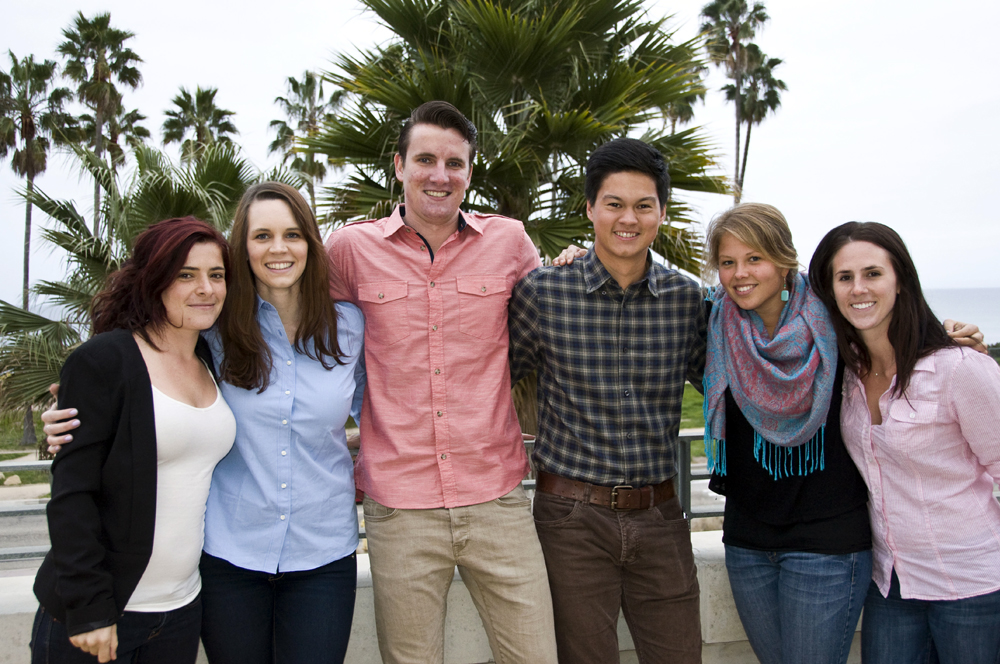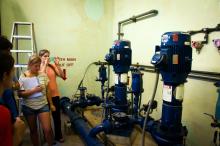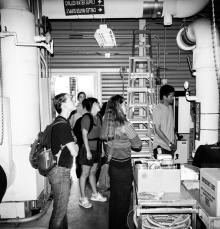


A typical showerhead dispenses water at a rate of about 2.5 gallons per minute. On a large residential campus such as UC Santa Barbara, where most students profess to spending 10 minutes daily under the nozzle, that adds up to hundreds of thousands of gallons gone every day in showers alone.
Factor in toothbrushing and handwashing at sinks that typically run around two gallons per minute, and toilets that in some cases release as many as five gallons with every flush, and suddenly one's morning regimen is a massive water-waster.
UCSB hopes to educate its campus community about such statistics, and, more importantly, reduce consumption and waste, with its just-approved Water Action Plan. The detailed document is the first of its kind in the UC system and, to date, is among the most comprehensive plans nationwide for a university.
"UCSB's Water Action Plan is a great step forward for conserving perhaps our most definitive resource in Southern California –– water," said Bruce Tiffney, dean of the College of Creative Studies and co-chair of the Chancellor's Sustainability Committee. "This far-sighted document details current usage and possible modes of usage reduction. It also provides estimates of economic costs and benefits; but in fact, these are almost inconsequential, as the question in water conservation is not ‘if,' nor even ‘when,' but rather ‘now.' This plan will help UCSB and, by example, other academic institutions, move on this important resource now."
The plan is the masterwork –– and master's project –– of six graduate students at UCSB's Bren School of Environmental Science and Management. Inspired by a UC Office of the President (UCOP) mandate that all 10 campuses create water conservation plans by 2014, Matthew O'Carroll and Katie Cole first proposed the effort one year ago. Shortly thereafter, Rebecca Dorsey, Dane Johnson, Briana Seapy, and Jewel Snavely joined the collective endeavor that dovetailed perfectly with Bren's eco-focused ethos.
"A lot of universities have climate action plans that, if you look historically over the last ten years, have focused mostly on energy, rising energy prices, and climate change. But now we're seeing this shift into water," said Dorsey. "We're coming into an era of more water awareness –– especially in California –– and I think you'll see more universities move from climate to water."
The Bren-born project really got under way last summer, with a mass of data collection from sites across UCSB, including the "wet well," where wastewater is collected, and the central pumping station that regulates water pressure campuswide. Their restroom audit took the team into every bathroom on campus to assess flush volumes and water flow in toilets, urinals, and faucet fixtures. They literally removed pipes and rerouted dozens of toilets into a bucket to measure gallons per flush.
Using their findings, and factoring in expected water rate increases and campus growth as reflected in UCSB's Long Range Development Plan, the group projected out through 2028. Besides revealing current usage, their final document –– a long-term roadmap for water conservation –– makes myriad recommendations for immediate and future savings.
Among the must-do's on the latter list, the students said, are restroom retrofits –– a relatively simple, low-cost remedy that could pay for itself, water-savings-wise, in just one year's time –– to bring all toilets, faucets, and aerators up to public standards for efficiency. Also, optimizing operations across UCSB's multiple cooling towers, which use chilled water to control temperature in rooms and buildings across campus, could achieve millions of gallons in water savings annually. Expanding the use of weather-based irrigation control could mitigate the estimated 3 million gallons of overwatering that occurs each year with timers and manual controls.
In addition to infrastructure improvements, the plan includes administrative recommendations, such as the adoption of real-time metering and the creation of a new staff position –– water manager. It also features outreach and education components, from implementing a campuswide water conservation education program, to incorporating conservation into academic curriculum.
"We laid out all the recommendations we felt were economically feasible, either now or in the future," O'Carroll said. "Once we leave, we don't know what the university will be faced with in terms of growth or whatever else may happen, but we accounted for everything that is known right now."
"This is a living document," Cole added. "We want it to be something the campus continues to come back to, and update, as technology advances and circumstances change. We see it as a roadmap. Some things here may not be feasible now, but we've laid out the conditions for which they would be feasible. We don't want this to collect dust. We want it to stay relevant."
Considering that UCSB by 2011 had already bested a UCOP mandate to reduce potable water use 20 percent by 2020, it is perhaps not surprising that the campus –– a longtime leader in higher education sustainability circles –– is on a fast track to further reductions. If it continues its efforts apace, and implements the recommendations of the Water Action Plan, the report states, UCSB "should be able to reduce total potable water use by an additional 20 percent by 2028."
"The Bren students have done a fantastic job developing this plan, which will serve as a template for other UC campuses to develop Water Action Plans of their own," said Ron Cortez, associate vice chancellor for administrative services and co-chair of the Chancellor's Sustainability Committee. "This speaks to the progressive nature of UCSB, not only in its ability to surpass California's 20 percent water-use reduction mandate nine years in advance, but also in our ability to assist others as they strategize for future reductions, conservation, and education of their campus communities. UCSB has shown great leadership with this plan, and we are excited about the finished product."
† Top image: L to R: Jewel Snavely, Rebecca Dorsey, Dane Johnson, Matthew O'Carroll, Briana Seapy, and Katie Cole, the Bren students behind the campus Water Action Plan.
Credit: Mo Lovegreen
†† Bottom image:
Their "water tour" took the grad students inside UCSB's central water pumping station, one of its cooling towers, and its wastewater collection facility.
Credit: Dane Johnson
Related Links



